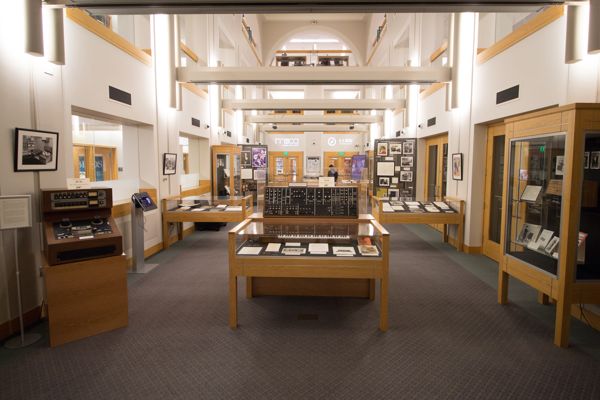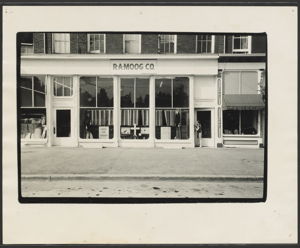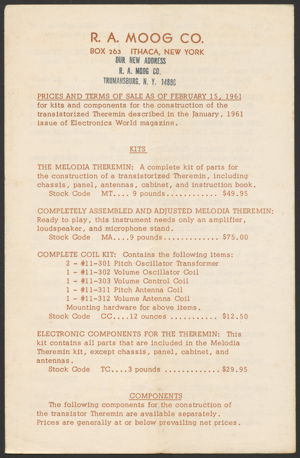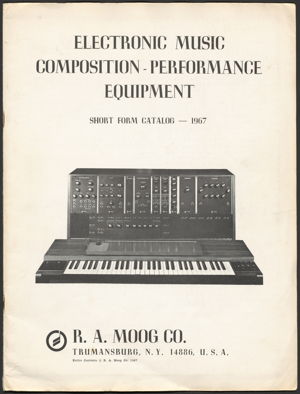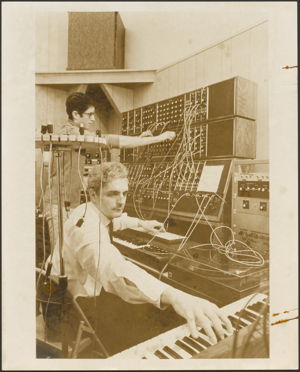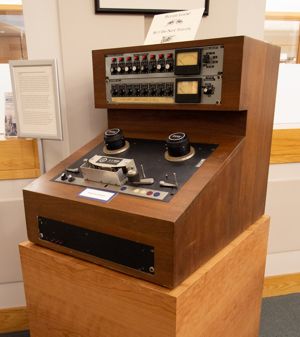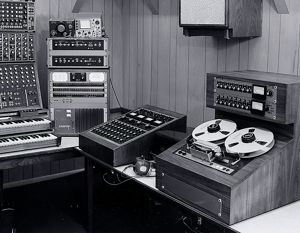Introduction
Robert (Bob) Arthur Moog (1934-2005) invented the first commercial electronic musical instrument—known as the “Moog Synthesizer”—over a three-year period of development from 1964 to 1967. Bob was an enterprising PhD student in Engineering Physics at Cornell University when he moved to Trumansburg, New York, a village twelve miles northwest of Ithaca, to establish his first synthesizer factory. In addition to the large modular Moog Synthesizer at the entrance to the exhibition gallery, R.A. Moog Co. began to manufacture and ship the more portable Minimoog Synthesizer in 1970.
It is rare for a whole new class of musical instruments to be invented, but the sound of the first Moog Synthesizers electrified audiences just as it electrified music. Showcased on the wildly popular 1968 album Switched-On Bach, created by Wendy Carlos, the modular Moog Synthesizer became a must-have instrument for rock groups such as the Beatles and the Rolling Stones. With members of his Arkestra in tow, Afrofuturist Sun Ra famously visited Trumansburg in 1969, leaving with a prototype Minimoog Model B that he proceeded to use in live performances and recordings. In the 50 years since the first production of the Minimoog, synthesizers of all types and brands have become ubiquitous in many genres of popular music, from prog rock to synthpop, from jazz to soul and funk, and from industrial rock to electronic dance music. Synthesizers set the mood for TV shows and movies. Today, even our phones and tablets incorporate synthesizers.
Late in life, Bob received growing recognition for his pioneering achievement. He was awarded Sweden’s Polar Prize in 2001 as well as a Technical Grammy in 2002, and was posthumously inducted into the National Inventors Hall of Fame in 2013. As in any story of complex technological innovation, many people—engineers, musicians, producers, marketers and others—were involved in the early years of R.A. Moog Co. Some actors remain invisible, such as the women with quilting skills who worked in Bob Moog’s Trumansburg factory at the delicate task known today as “stuffing circuit boards.” Bob’s loving and supportive family, notably his wife Shirleigh, played an important role.
Bob was a humble man who never sought the limelight. He would have shaken his head, made a joke, and puzzled about all the attention while, we hope, secretly enjoying it. In focusing this exhibition on Bob Moog and his synthesizer, we also honor the many other people who contributed to the history of this incredible instrument and the industry it spawned.
The Robert Moog Papers (ca. 1955—2005), from which most of the items in this exhibition are drawn, were a gift to Cornell University Library from Bob’s second wife, Ileana Grams-Moog, in 2013.
The original Moog factory in Trumansburg, New York, was in a former furniture store. Today, the building houses a pizzeria. In 2016, a plaque was erected outside the store to commemorate the place where the Moog Synthesizer was invented.
This catalog offering Theremin kits and components for sale was printed before Bob and Shirleigh moved from Ithaca to Trumansburg. The company’s “Our New Address” ink stamp, indicating the recent move, appears at the top.
This 1967 Moog company catalogue is one of the first to use the word “synthesizer” to describe a complete assemblage of electronic music modules. The synthesizer was marketed as high-end audio equipment and was sold mainly to institutions such as university studios and departments, wealthy composers, or rock stars. Modules could be purchased separately. Equipment ranged in price from $2800 to $6200. With a high-end reel-to-reel tape recorder included, this was equivalent to the cost of a small house.
There were no instruction manuals in the early days of synthesis, and learning the ropes was no easy task. Jon Weiss was a talented electronic musician known as “the man from Moog” who would go on the road to show musicians how to set up and use their new modular gear. Jon famously took a synthesizer to London and lived with Mick Jagger for a month, showing him how to operate the instrument. Jagger used the synthesizer in the 1970 cult movie Performance, directed by Donald Cammell and Nicolas Roeg. Jon later worked with Donald Buchla, Moog’s fellow electronic instrument inventor on the West Coast.
Designed for use with the 900 Series Moog Synthesizer, ca. 1966-68. This 900 series synthesizer was custom built for Mother Mallard’s Portable Masterpiece Company. Fronted by David Borden, who was later appointed as a Senior Lecturer in Cornell University’s Department of Music, Mother Mallard was the world’s first live synthesizer ensemble. The group often acquired the latest Moog experimental equipment, including the first Minimoog Synthesizer, known as the Min A.
The Moog factory was unique in having a recording studio attached to it. This studio grew out of a three-week electronic music seminar Bob ran, inviting musicians to visit his factory. He provided them with the latest equipment, including tape recorders. A tape recorder was crucial in the making of early electronic music owing to the elaborate configurations of patch cords and knob settings required to create sounds, which could not be preserved. Many a musician reported discovering an incredible sound from the instrument only to find that they couldn’t replicate it in the next session! The rule was: get the sound down on tape while you can.
Unusually, but in keeping with Bob’s approach to synthesis, the eight-track tape recorder shown here could be controlled via the voltage delivered to it, which gave musicians and engineers much greater control over the elaborate taping process. The speed of recording (and thus the pitch of the sounds when played back) could be adjusted in real time via input from a synthesizer or other device. After recording, sounds could be further processed by cutting and splicing the tape as well as continuing to alter the speed—and even the direction—of playback.
This photograph shows the reel-to-reel recorder at the Moog studio. The studio not only provided a way for musicians to record their compositions, but was also crucial for Bob and the engineers to observe how musicians used the equipment. The Minimoog, for example, emerged from Bill Hemsath’s observation that musicians tended to prefer a particular set-up of modules. In this way, the studio offered Bob a sound lab in which he could further his research. By 1970, he parlayed this knowledge into the sale of integrated studio setups, including speakers, tape recorders, and mixers as well as synthesizers.
